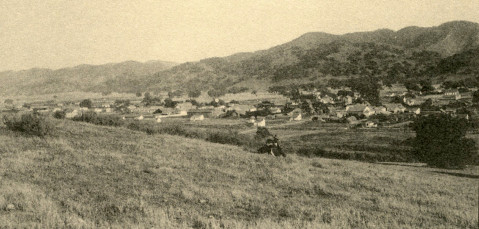Earthquake in 1902 Shook Los Alamos
'Quakes and Aftershocks Tumbled Buildings and Chimneys

Everyone knows that California is earthquake country, and certainly Santa Barbara County has suffered through its share of serious ones over the years. Undoubtedly the 1925 temblor is the best-known, which caused heavy damage in Santa Barbara. Less well known is the quake that struck the small town of Los Alamos on July 27, 1902. Estimated at about 7.0 on the Richter scale, the quake would have been stronger than the more famous ’25 shake.
There had been a warning tremor around 5 p.m. that day, and the first great shock hit a little after 11 p.m. One eyewitness later reported “a most terrific sound like thunder and the discharge of a thousand cannons seemed to envelop everything.” Three distinct shocks brought almost every chimney in town tumbling down. No one slept the rest of the night as some 25 aftershocks rolled through the town from 11 p.m. to five the next morning.
For the next few days, residents bore up under continuing aftershocks. Everyone felt the worst had passed until the early morning hours of July 31. A little after two, the “most terrific, violent, sudden terror” struck. Residents later agreed that this earthquake had a strange circular or rotary feel to it. One person compared the experience to being caught in a whirlpool. In the homes left standing, furniture was pushed to the center of rooms. It appears this second quake was even more violent than the one on the 27th.
Again, locals were forced to endure aftershocks that never seemed to stop. Although not as severe as the two major temblors, they often caused serious damage to buildings that were already weakened. The Presbyterian Church lost its front wall, and a number of stores in the small business district were wrecked.
This series of events not only shattered walls but nerves as well. Could these incessant aftershocks portend yet a third major upheaval? The narrow-gauge Pacific Coast Railway, which ran from Port Harford near San Luis Obispo through the Los Alamos Valley to Los Olivos, ran a special train of 14 cars to Los Alamos, and most of the town’s residents evacuated. Two observers from the University of California at Berkeley traveled south to survey the damage, one of whom advised that the evacuees should seek shelter in caves.
Incredibly, there were no serious injuries. The tremors seemed to be centered in the immediate vicinity of Los Alamos; some movement was felt in Santa Maria and in Santa Barbara but was considered inconsequential. The only additional damage of note was at the Careaga oilfields nearby where two oil storage tanks with a total capacity of over 3,000 barrels ruptured.
The earthquake did garner some attention around the state, and concern soon grew in Santa Barbara that people would be afraid to visit the region. One newspaper pointed out that a rare earthquake was a small price to pay for living in such a beautiful place. The writer went on to state that if earthquakes “happen once in half a century it is notable” and accused the media of sensationalism and hysteria. The 1925 Santa Barbara earthquake was less than 25 years away.
Michael Redmon, director of research at the Santa Barbara Historical Museum, will answer your questions about Santa Barbara’s history. Write him c/o The Santa Barbara Independent, 12 East Figueroa Street, Santa Barbara, CA 93101.



